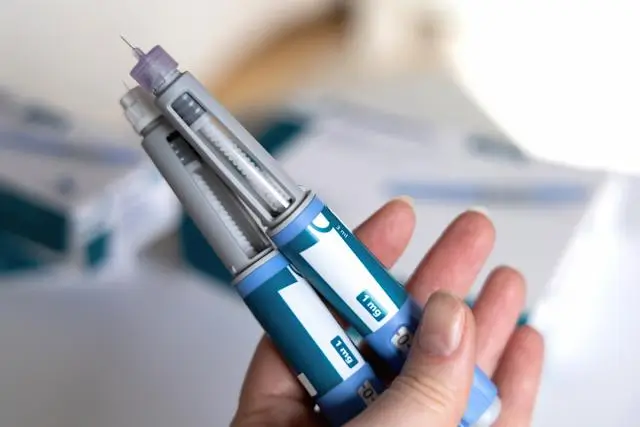
What Is the Active Ingredient in Ozempic?
Ozempic
2025-08-18
Ozempic contains semaglutide, a long-acting GLP-1 receptor agonist that mimics a natural gut hormone to regulate blood sugar and appetite. Learn how semaglutide works, its molecular design, and why it’s effective for diabetes and weight management.
Joanna Carr
If you’ve ever wondered what makes Ozempic work, the answer lies in a powerful molecule called semaglutide. This compound is a synthetic version of a natural hormone called GLP-1 (glucagon-like peptide-1), which helps regulate blood sugar and appetite.
What sets semaglutide apart is its long-lasting design. Through small structural changes that improve stability and enable binding to albumin (a protein in the blood), semaglutide remains active for about one week after each dose. That’s why Ozempic only needs to be injected once weekly—a major convenience compared to many other injectable therapies.
In this article, we’ll explore how semaglutide is designed, how it works in the body, and why it’s so effective as the active ingredient in Ozempic.
Key Takeaways
- The active ingredient in Ozempic is semaglutide, a synthetic version of the natural hormone GLP-1.
- Semaglutide works by increasing glucose-dependent insulin secretion, reducing excess glucagon, and curbing appetite—all of which support blood sugar control and weight management.
- Structural changes give semaglutide a long half-life of about one week, allowing Ozempic to be injected once weekly.
- Originally approved for type 2 diabetes, semaglutide is also available as Rybelsus® (oral tablets for T2D) and Wegovy® (for chronic weight management).
- Clinical studies show benefits beyond glucose control, including sustained weight loss and cardiovascular risk reduction in certain patients.
- Like all medications, semaglutide has a safety profile: common side effects include nausea and gastrointestinal upset, and it should be avoided in those with a history of MTC, MEN2, or pancreatitis.
About: Doctor Medica is your trusted supplier of top-quality dermal fillers, viscosupplements, and more for your medical practice. We offer genuine products from leading brands at the lowest prices in the market. If you’re looking to order Ozempic online for your practice, contact Doctor Medica today.
Semaglutide Overview and Drug Class
Semaglutide is the active ingredient in Ozempic, approved by the U.S. Food and Drug Administration (FDA) in 2017 for type 2 diabetes management. Since then, it has become one of the most widely prescribed GLP-1 therapies worldwide due to its strong balance of efficacy and safety.
Key features of semaglutide’s drug class include:
- GLP-1 Receptor Activation: Stimulates insulin release when glucose levels are high.
- Glucagon Suppression: Reduces excessive release of glucose from the liver.
- Appetite Regulation: Curbs hunger signals, supporting weight loss.
By targeting multiple pathways at once, semaglutide helps maintain stable blood sugar levels, improve metabolic health, and reduce calorie intake. These combined effects set it apart from older diabetes drugs that focus on only one mechanism.
What Is the Active Ingredient in Ozempic? Semaglutide’s Mechanism of Action and Metabolic Effects

To fully understand what the active ingredient in Ozempic is, it is essential to see how semaglutide functions inside the body. Unlike traditional medications that target only one aspect of glucose control, semaglutide works on multiple pathways to regulate blood sugar, appetite, and metabolism. Its multi-layered mechanism makes it highly effective for type 2 diabetes management and weight reduction.
- GLP-1 Receptor Activation: Enhances insulin release only when blood sugar is high, lowering the risk of hypoglycemia.
- Suppression of Glucagon Secretion: Prevents the liver from releasing too much glucose after meals.
- Lower Hepatic Glucose Output: Achieved primarily through glucagon suppression, helping reduce fasting glucose.
- Delayed Gastric Emptying: Slows the rate at which food leaves the stomach, prolonging satiety and reducing post-meal glucose spikes.
- Improved Glycemic Control and Insulin Sensitivity: By lowering both glucose levels and body weight, semaglutide can modestly improve insulin sensitivity across tissues.
- Support for Weight Loss: Decreases appetite and promotes gradual, sustainable weight reduction.
Together, these actions explain why semaglutide is considered a breakthrough therapy—it addresses blood sugar regulation, weight management, and metabolic balance in a single treatment.
Clinical Benefits in Type 2 Diabetes and Weight Management of the Active Ingredient in Ozempic

The clinical value of semaglutide goes far beyond short-term glucose control. Research shows it can:
- Lower HbA1c significantly, often bringing patients closer to their individualized targets.
- Reduce the risk of diabetes complications, including nerve damage, kidney disease, and vision problems.
- Support durable weight loss, an important factor for improving insulin sensitivity and reducing overall metabolic strain.
- Protect the heart: Large trials show semaglutide reduces the risk of major cardiovascular events (heart attack, stroke) in people with type 2 diabetes at high CV risk and in those with established CVD and obesity.
Combined with consistent monitoring and adherence, semaglutide supports safer, more stable long-term glucose control. For those using injectables, rotating between approved Ozempic shot locations helps minimize local skin reactions while maintaining comfort.
What Is the Active Ingredient in Ozempic? Its Safety Profile and Contraindications
Like all prescription therapies, semaglutide comes with a safety profile to be aware of. The most common side effects include nausea, vomiting, diarrhea, and constipation, particularly in the first weeks of treatment. These are usually mild to moderate and tend to lessen as the body adapts. Starting at a low dose and gradually increasing helps improve tolerance.
Key safety considerations:
- Contraindications: Do not use in patients with a personal/family history of medullary thyroid carcinoma (MTC) or multiple endocrine neoplasia type 2 (MEN2).
- Pancreatitis: Avoid use in patients with a history of pancreatitis when possible; discontinue immediately if suspected.
- GI disease: Use caution in those with severe gastrointestinal conditions such as gastroparesis.
- Diabetic Retinopathy: Rapid improvements in HbA1c may temporarily worsen diabetic retinopathy in susceptible patients. Monitor closely if a pre-existing disease is present.
With appropriate patient selection, education, and monitoring, semaglutide remains a safe and effective long-term option.
Conclusion
The active ingredient in Ozempic is semaglutide, a GLP-1 receptor agonist that has reshaped modern diabetes and weight management care. By regulating glucose levels, reducing appetite, and lowering cardiovascular risk, it offers benefits well beyond traditional therapies.
Still, semaglutide isn’t right for everyone. Patients should always review their medical history with a healthcare provider to confirm safety and tailor therapy to their needs. With proper administration, rotation of injection sites, and monitoring, semaglutide can be a cornerstone treatment in type 2 diabetes and metabolic health.
FAQs
1. What is the active ingredient in Ozempic?
The active ingredient is semaglutide, a GLP-1 receptor agonist designed to regulate blood sugar and support weight loss in type 2 diabetes. (Note: Ozempic does not have formal approval for weight loss, though many patients experience it as a benefit.)
2. How does semaglutide help with weight loss?
It slows digestion and increases satiety, which naturally reduces calorie intake and supports gradual, sustainable weight loss.
3. Who should not use Ozempic?
People with a history of MTC or MEN2 should not use Ozempic. Those with a history of pancreatitis generally should consider alternatives; they must first discuss any risk with their clinician.
4. Where can I inject Ozempic?
It is injected subcutaneously in the abdomen, thigh, or upper arm. Rotating between sites helps reduce skin irritation. (The site does not change how the body absorbs the medication, only comfort and skin health.)
References
Pillarisetti L, Agrawal DK. Semaglutide: Double-edged Sword with Risks and Benefits. Arch Intern Med Res. 2025;8(1):1-13. doi:10.26502/aimr.0189
Rana MJ. Semaglutide: A GLP-1 agonist for treating type 2 diabetes. J Med Chem. 2020;63(3):905-927.
Related Articles
Joanna Carr
Comprehensive Product Review: Dermalax Deep Plus Hyaluronic Acid Filler
This article provides an in-depth analysis and review of Dermalax Deep Plus hyaluronic acid filler. It covers aspects such as effectiveness and lengev...
Joanna Carr
Durolane FDA Approval Status
Discover the FDA approval status of Durolane, a hyaluronic acid injection for osteoarthritis, and its impact on pain relief and joint health.
Joanna Carr
Does Lumigan Change Eye Color? – What You Need to Know
Learn whether Lumigan changes eye color and what you need to know about this potential side effect. Understand the causes, implications, and patient c...


